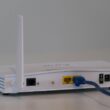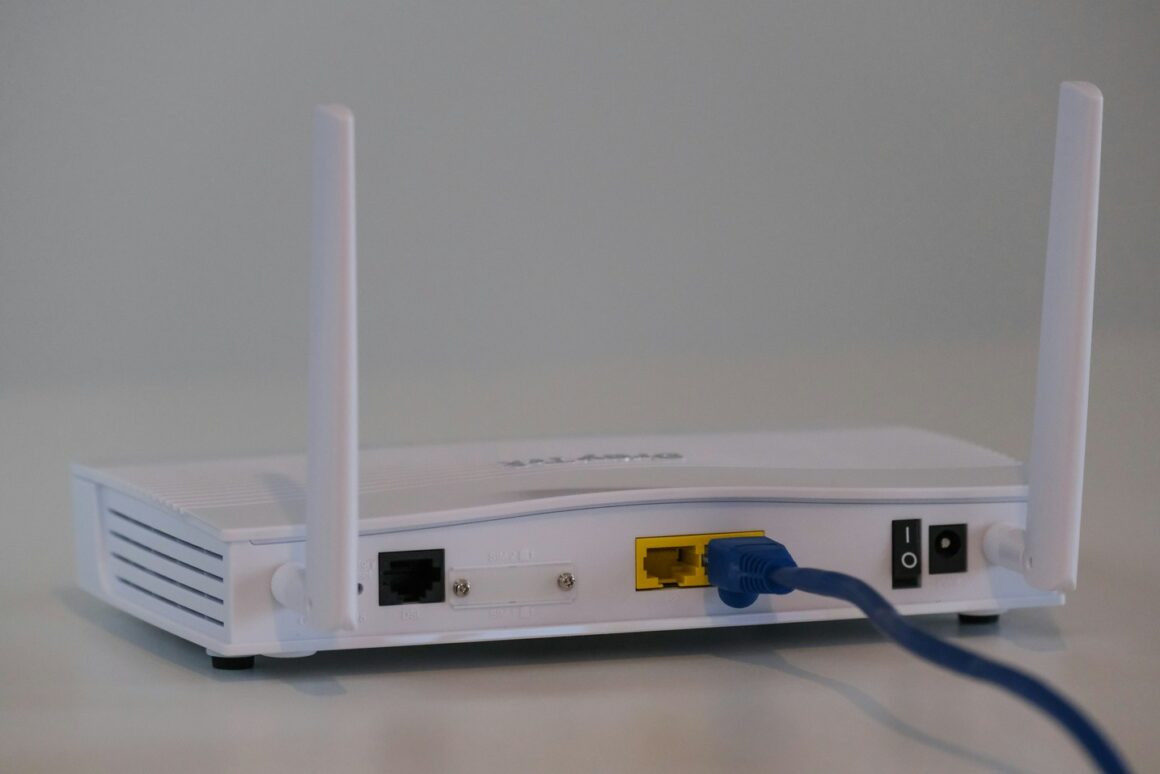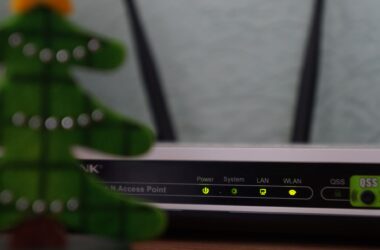1. Introduction
In the era of ubiquitous internet connectivity, having a stable and reliable network is more crucial than ever. Whether it’s for streaming high-definition videos, engaging in competitive online gaming, or ensuring smooth telecommuting, the quality of your internet connection can significantly impact your digital experience. This is where understanding the different types of network connections, specifically Wifi and LAN, becomes essential.
1.1 Wifi vs. LAN: A Quick Overview
Wifi, or wireless networking, allows devices to connect to the internet without physical cables. It offers the convenience of mobility and is the most common way to access the internet in homes and public spaces. However, Wifi connections can be susceptible to interference, range limitations, and fluctuations in speed, especially in crowded areas or buildings with thick walls.
On the other hand, LAN, or Local Area Network, connections involve connecting devices to the internet via ethernet cables. This type of connection is typically more stable and secure than Wifi. It provides faster data transfer rates and a more consistent connection, which is why high-stakes environments, such as data centers and large offices, rely on wired networking.
1.2 Enter Wifi to LAN Converters
Wifi to LAN converters are devices that bridge the gap between these two types of connections. They allow devices that normally connect via Wifi to instead use a LAN connection. This can be particularly useful for older desktop PCs, gaming consoles, and any device where Wifi is either unavailable or unreliable.
1.3 Why and When to Use a Wifi to LAN Converter?
Understanding when and how to use a Wifi to LAN converter can greatly enhance your network’s reliability and performance. For instance, in areas of your home where Wifi signal is weak or unstable, a converter can provide a direct, wired connection, ensuring better speed and reliability. This is also advantageous for security-sensitive applications where a wired connection’s robustness against eavesdropping and hacking is preferable.
In this blog post, we will delve deeper into the mechanics of Wifi to LAN converters, explore their benefits, and provide practical advice on setting them up effectively. By the end, you’ll be equipped with all the knowledge needed to decide if a Wifi to LAN converter is right for your networking needs.
2: How to Use a Wifi to LAN Converter
Using a Wifi to LAN converter can significantly improve your network stability and speed, particularly in areas where Wifi signals are weak or unreliable. In this section, we will guide you through the setup process, address common setup challenges, and share best practices for maintaining a stable connection.
2.1 Step-by-Step Guide on Setting Up a Wifi to LAN Converter
- Select the Right Converter: Before you begin, ensure that you have the correct type of converter that supports your device’s connectivity requirements and your router’s specifications.
- Unbox and Connect: Start by unboxing your Wifi to LAN converter. You will typically find the converter itself, a power adapter, and an Ethernet cable in the box. Connect the Ethernet cable from your router to the converter’s LAN port.
- Power On: Connect the power adapter to your converter and plug it into an electrical outlet. Some converters might have a power switch; make sure it is turned on.
- Connect Your Device: Use another Ethernet cable to connect your device (such as a PC, gaming console, or smart TV) to another port on the converter. Ensure the connections are tight and secure.
- Configuration: Depending on the model, some converters might require configuration through a web interface. Consult the user manual for the IP address and login details. Access this interface through a web browser on a computer connected to the same network and configure as needed.
- Test the Connection: Once everything is connected and configured, test the connection by navigating to a website or performing a speed test. This will confirm that the internet is working through your new setup.
2.2 Common Setup Challenges and Troubleshooting Tips
- Device Not Recognizing the Connection: If your device does not recognize the network connection, ensure all cables are securely plugged in and the converter is powered on. Restarting both the converter and your device can also help.
- Slow Connection Speeds: If the connection is slower than expected, check to make sure that the Ethernet cables are not damaged and are of good quality. Consider upgrading to CAT6 cables if you are using older versions.
- Intermittent Connectivity: This can be caused by interference or poor quality cables. Ensure that the Ethernet cables are away from large electrical appliances and replace them if they are old or of low quality.
- Accessing Configuration Settings: If you have trouble accessing the web interface for your converter, make sure you are using the correct IP address provided in the manual. Also, ensure that your computer is on the same network segment or consider connecting directly to the converter with an Ethernet cable.
2.3 Best Practices for Ensuring Stable Connectivity
- Use Quality Cables: Investing in high-quality, shielded Ethernet cables can significantly reduce interference and increase speed.
- Keep Firmware Updated: Regularly check for firmware updates for your Wifi to LAN converter. Manufacturers often release updates to improve performance and security.
- Optimal Placement: Place your Wifi to LAN converter in a central location relative to your router and the devices it is connected to to minimize the length of the Ethernet cables and potential interference.
- Secure Your Network: Ensure your network’s security by setting strong passwords, using the latest encryption standards, and regularly monitoring connected devices.
By following these steps and tips, you can maximize the effectiveness of your Wifi to LAN converter, ensuring a stable and speedy network connection that leverages the best aspects of both wireless and wired technologies.
3: Benefits of Using Wifi to LAN Converters
While the convenience of wireless internet is undeniable, there are distinct benefits to using a Wifi to LAN converter, especially in environments where stability, speed, and security are paramount. In this section, we will explore the advantages of employing such a device in your networking setup.
3.1 Improved Connection Stability and Speed
One of the most compelling reasons to use a Wifi to LAN converter is the significant improvement in network stability and speed. Here’s how it helps:
- Reduced Latency: LAN connections typically offer lower latency compared to wireless connections. This is crucial for applications where timing is critical, such as online gaming or video conferencing.
- Consistent Speeds: Unlike Wifi, which can fluctuate based on distance from the router, physical obstructions, and interference from other wireless devices, LAN provides a consistent speed across the network.
- Better Bandwidth Utilization: Ethernet cables can handle more data compared to Wifi, providing a more robust connection for data-intensive tasks like HD video streaming or large file transfers.
3.2 Enhanced Security Features Over Wifi Connections
Security is another major advantage of using a Wifi to LAN converter. Wired connections inherently offer superior security benefits over wireless setups:
- Reduced Risk of Interception: Since LAN connections require physical access for data interception, they are less susceptible to eavesdropping attacks that are more common with Wifi networks.
- Controlled Access: Physical connections limit access to the network to only those devices that are physically connected, offering an additional layer of security.
- No Broadcasts: Unlike Wifi that broadcasts data that can potentially be captured by anyone within range, data on a LAN is transmitted through the cable, reducing exposure to potential hackers.
3.3 Situations Where a LAN Connection Outperforms Wifi
While Wifi is sufficient for most day-to-day internet needs, certain scenarios particularly benefit from the robustness of a LAN connection:
- High-Density Environments: In places with many overlapping Wifi networks, such as apartment buildings or office complexes, Wifi signals can interfere with each other, leading to connectivity issues. LAN does not face such interference.
- Large File Transfers: For businesses that require the transfer of large amounts of data quickly and reliably, such as media production companies, LAN can dramatically improve transfer speeds and reliability.
- Sensitive Applications: In environments where data privacy and security are critical, such as financial institutions or healthcare facilities, the security benefits of LAN make it a preferred choice.
- Stable Connections for Critical Operations: For operations that require an uninterrupted connection, such as server maintenance or remote surgical procedures, the stability of a LAN connection is indispensable.
By integrating a Wifi to LAN converter into your network setup, you can leverage these benefits, enhancing not only the performance but also the security and reliability of your internet connection. Whether you are a gamer needing precision and speed, a professional handling sensitive data, or simply a user tired of spotty Wifi, a Wifi to LAN converter could be an invaluable addition to your tech toolkit.
4: When to Use a Wifi to LAN Converter
While Wifi is ubiquitous in providing internet access across various environments, its limitations become apparent under certain conditions. A Wifi to LAN converter can mitigate these issues by providing a more reliable wired connection. Here are some specific scenarios where using a Wifi to LAN converter is particularly beneficial:
4.1 In Homes with Poor Wifi Coverage
Many homes have areas known as “dead zones” where Wifi signals are weak or non-existent. This can be due to distance from the router, thick walls, or interference from other devices. In these cases, a Wifi to LAN converter can be a game-changer:
- Extend Connectivity: By connecting a Wifi to LAN converter to a wired Ethernet port in a different part of the home, you can extend reliable internet access to areas that previously had poor coverage.
- Enhance Performance: Devices connected via ethernet through the converter will enjoy faster and more stable connections, improving the overall user experience, particularly for activities like HD video streaming or participating in video calls.
4.2 In Offices That Require Stable, High-Speed Internet for Critical Tasks
Offices, especially those that handle large volumes of data or require constant access to cloud-based resources, need dependable and fast internet connections to function efficiently:
- Boost Productivity: A stable connection reduces the likelihood of disruptions during critical tasks such as video conferences, large data uploads, or real-time collaboration on cloud platforms.
- Secure Sensitive Data: With enhanced security features of a wired connection, sensitive information is better protected from potential cyber threats, an essential consideration for businesses handling confidential data.
4.3 For Gaming and Streaming Services That Demand Uninterrupted Connections
For gamers and streaming enthusiasts, even a minor disruption can degrade the experience significantly. Here’s why a Wifi to LAN converter can be critical:
- Reduce Lag and Buffering: Wired connections minimize the lag and buffering that often plague gamers and streamers on wireless networks. This is crucial for maintaining a competitive edge in gaming and ensuring a smooth streaming experience.
- Stable Uploads and Downloads: When live streaming, stable uploads are as critical as downloads, something that wired connections facilitate more reliably than Wifi.
4.4 Additional Considerations
Using a Wifi to LAN converter not only enhances connectivity in these specific scenarios but also provides a generally more robust internet setup. It’s a suitable upgrade for anyone facing regular issues with Wifi stability or for settings where internet performance is critical to daily operations. Whether you’re upgrading your home network, enhancing your office connectivity, or setting up the perfect gaming or streaming station, a Wifi to LAN converter is an invaluable tool that bridges the gap between wireless convenience and wired reliability.
5: Choosing the Right Wifi to LAN Converter
Selecting the right Wifi to LAN converter is crucial for optimizing your network’s performance. It’s important to consider several factors to ensure compatibility with your existing setup and to achieve the best possible results. Here’s what you need to keep in mind when shopping for a Wifi to LAN converter:
5.1 Factors to Consider
- Compatibility with Existing Equipment
- Device Support: Ensure the converter supports the specific devices you plan to connect, whether they are PCs, gaming consoles, smart TVs, or other networked devices.
- Router Compatibility: Check that the converter can interface correctly with your existing router. This includes ensuring it can handle the same Ethernet standards (e.g., Gigabit Ethernet).
- Operating Systems: Some converters might require specific drivers or have compatibility issues with certain operating systems. Verify that the converter is compatible with the OSs running on your networked devices.
- Speed and Performance Specifications
- Maximum Data Rates: Look at the maximum throughput the converter supports. If you have a high-speed internet plan or you transfer large files within your network, opt for a converter that can handle higher data rates (ideally Gigabit speeds).
- Quality of Service (QoS): Some converters feature QoS settings that prioritize traffic to ensure high performance for critical tasks like streaming or gaming.
- Reliability: Consider the build quality and reliability of the converter to ensure it can maintain a stable connection without needing frequent resets or suffering from heat issues.
- User Reviews and Brand Reputation
- Consumer Feedback: Read user reviews to gauge how well the converter performs in real-world scenarios. Look for comments on its reliability, ease of use, and customer support.
- Expert Opinions: Check tech websites and forums for professional reviews to get a comprehensive view of how well the converter stacks up against its competitors.
- Brand Reputation: Established brands generally offer better customer support and warranty terms. They are also more likely to release firmware updates that fix bugs and enhance device security.
5.2 Recommendations for Top Models on the Market
To help you make an informed choice, here are a few highly recommended models currently available:
- TP-Link AV1000: This model is favored for its plug-and-play simplicity and high-speed capabilities, supporting up to 1000 Mbps. It’s an excellent choice for heavy internet users.
- Netgear PowerLINE 1200 Mbps: Known for its robust performance, this converter kit extends your network coverage without sacrificing speed, making it ideal for streaming HD content and gaming.
- D-Link DHP-601AV: Offering speeds up to 1000 Mbps, this model is known for its reliability and ease of installation, making it a good fit for both home and small office environments.
- Trendnet TPL-408E2K: This set offers advanced electrical noise filtration and a built-in socket on each adapter, ensuring that no outlet goes to waste. It’s a great choice for users who need to maintain multiple high-speed connections.
When choosing a Wifi to LAN converter, consider your specific needs and the configurations of your home or office network. With the right converter, you can significantly enhance your internet experience, combining the best of both wired and wireless networking.
6: Installation and Setup Tutorial
Installing a Wifi to LAN converter can vastly improve your network’s stability and speed. This section provides a detailed walkthrough on setting up your converter, along with tips to optimize your network and ensure everything is functioning correctly.
6.1 Detailed Walkthrough on Installing a Wifi to LAN Converter
Step 1: Unpack and Inspect Your Converter
- Begin by unpacking your Wifi to LAN converter. Ensure all components, including the power adapter, Ethernet cables, and any software CDs, are included.
Step 2: Connect to Your Router
- Connect one end of an Ethernet cable to one of the LAN ports on your router and the other end to the input port on your Wifi to LAN converter.
Step 3: Power On the Converter
- Plug the power adapter into your converter and then into an outlet. Some converters might have an indicator light to show that it’s powered on.
Step 4: Connect Your Devices
- Use additional Ethernet cables to connect your devices (e.g., computers, gaming consoles) to the output ports on the converter. Ensure the connections are secure.
Step 5: Perform Initial Setup
- If your converter requires configuration, insert any installation CD into your computer, or download the necessary software from the manufacturer’s website. Follow the on-screen instructions to complete the setup.
Step 6: Test the Connection
- Open a web browser on any connected device and try navigating to a website or run a speed test to ensure the internet is working via the converter.
6.2 Tips for Optimizing Your Network Setup
Optimize Ethernet Cable Placement
- Arrange Ethernet cables neatly to avoid interference and potential damage. Use cable ties if necessary to keep everything tidy and secure.
Update Network Drivers
- Ensure that all network drivers on your connected devices are up-to-date to maintain compatibility and performance.
Configure QoS Settings
- If available, configure Quality of Service (QoS) settings in your router to prioritize bandwidth for critical tasks like video calls and online gaming.
Regular Firmware Updates
- Check for and install firmware updates for your converter regularly. Manufacturers often release updates to improve performance and security.
6.3 How to Verify That Your Converter is Functioning Properly
Check Connection Status
- Most converters have LED indicators for power and network link activity. Ensure these are active and stable, indicating a proper connection.
Run Speed Tests
- Conduct speed tests from devices connected through the converter to verify they are receiving adequate bandwidth.
Monitor for Consistency
- Observe the connectivity over a few days to ensure there are no intermittent drops or significant fluctuations in speed.
Review Device Logs
- If your converter supports logging, review the logs for any errors or warnings that could indicate a problem.
Check for Physical Issues
- Regularly inspect the physical connections and the device itself for any signs of wear or damage that could affect performance.
By following these steps, you can ensure a successful installation of your Wifi to LAN converter and enjoy a more reliable and efficient network setup. These tips will help you maximize the potential of your internet connection, making your online experience smoother and more secure.
Conclusion
In this comprehensive guide, we’ve explored the essential aspects of Wifi to LAN converters, a pivotal tool for enhancing your internet connectivity. We’ve discussed how these converters can stabilize your connection, increase your internet speed, and provide a more secure networking environment compared to standard Wifi setups.
Recap of Key Points
- Understanding Wifi to LAN Converters: We introduced what these devices are and why they might be necessary for your network.
- Installation and Usage: We provided a step-by-step guide on how to set up a Wifi to LAN converter, along with troubleshooting tips to ensure a smooth installation process.
- Benefits: We covered the numerous advantages, including improved connection stability and enhanced security features.
- Ideal Scenarios for Use: We identified specific situations where a Wifi to LAN converter would be particularly beneficial, such as in homes with poor Wifi coverage, offices that demand high-speed internet for critical tasks, and environments like gaming or streaming that require uninterrupted connections.
- Choosing the Right Converter: We offered advice on selecting the best converter for your needs, emphasizing compatibility, performance specifications, and user reviews.
If you find yourself frequently frustrated by unreliable Wifi or need a more secure and stable internet connection, consider integrating a Wifi to LAN converter into your network setup. This device could dramatically improve your online experiences, whether you’re streaming high-definition videos, engaged in competitive gaming, or handling sensitive data in a professional setting.
Join the Conversation
- We invite you to comment below with any questions you might have or to share your personal experiences with Wifi to LAN converters. Your insights could help others make informed decisions and learn from real-world applications of this technology.
- Don’t miss out on more tech tips and guides like this one! Subscribe to our newsletter for the latest updates and expert advice tailored to your tech needs.
- Follow our blog on social media and sign up for email updates to stay connected and informed about all things tech.
Your engagement and feedback are invaluable to us, and we look forward to providing you with the content that helps you navigate the complex world of technology more easily. Thank you for reading, and we hope this guide has been both informative and helpful!







